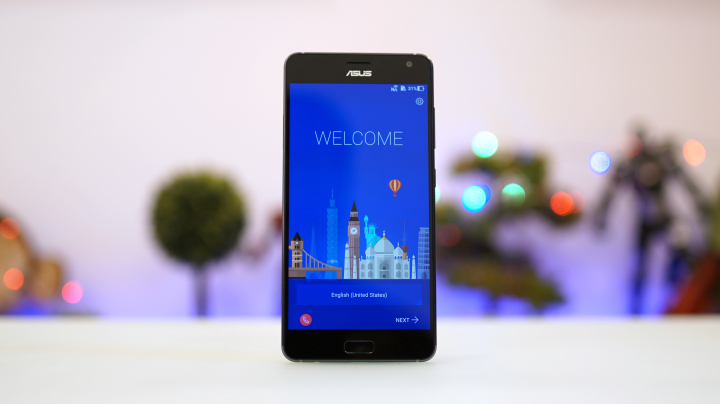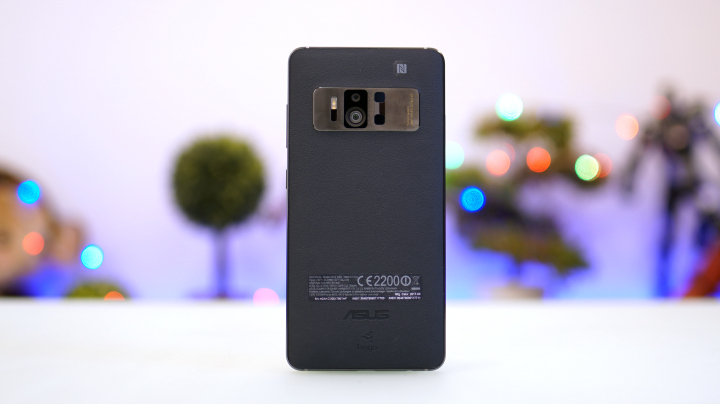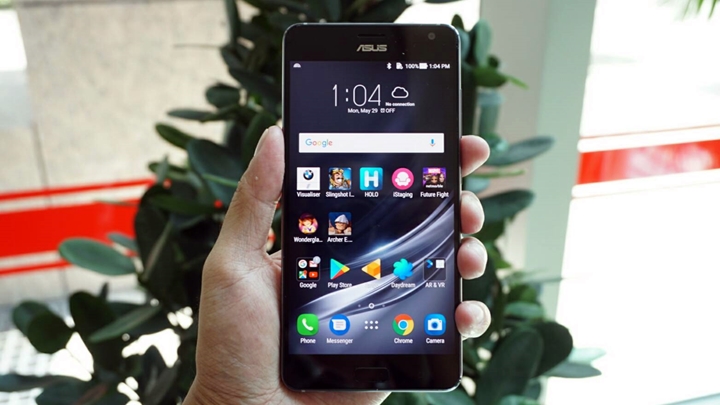It was in 2014 when Google first introduced Project Tango, a technology for smartphones that enables them to fully tap on Augmented Reality (AR) applications. Then in January of this year, ASUS announced its first smartphone to feature such tech – the Zenfone AR. Equipped with a motion tracking and depth sensing rear cameras, the Zenfone AR is not only certified for Google Tango AR, but also for Daydream VR applications. Check out our review of the ASUS Zenfone AR.

Table of Contents
The ASUS Zenfone AR is a pretty large smartphone thanks to its 5.7-inch Super AMOLED display which is the same size and type as the ASUS Zenfone 3 Deluxe ZS570KL. It’s got a higher resolution screen though at Quad HD which equates to 515ppi and is mounted with Gorilla Glass 4.

Above the display are the earpiece, sensors, and the 8MP front camera. Down below are the backlit capacitive keys for navigation and the physical home button which also works as the fingerprint scanner.

Located on the left side is the hybrid SIM tray, while on the right are the volume keys and the power/lock button.

Up top are the secondary microphone and a couple of antenna bands, while down at the bottom are the headset port, main microphone, USB-C port, loudspeaker, and another set of antenna bands.

The back part is where all the fancy stuff happens. There’s a metal plate that houses the phone’s imaging technologies like the 23MP Sony IMX318 main shooter, TriTech AF system, Motion tracking camera, and the Depth sensing camera with IR projector.

On the hands, the Zenfone AR feels like your typical large-screened premium smartphone. The metal frame is cool to the touch while the leatherette back panel adds class and grip at the same time.

It might be chunky at its thickest point at 8.95mm but the curved sides make up for it. It’s a bit hefty though at 170g but that’s understandable, although we suggest handling it with extra care as it is top heavy and might easily topple from your hand.
At 5.7 inches, the Zenfone AR is basically a phablet, although this screen size is pretty common nowadays. Resolution is high at 2560 x 1440 pixels or QHD which equates to a pixel density of 515ppi, which is good considering that this device will be used for VR purposes. Protecting it is Corning’s Gorilla Glass 4.

In addition, it has rich colors and deep blacks thanks to the Super AMOLED screen. Although you might want to switch on the Super Color mode inside settings to get those punchy colors.

As for audio, the Zenfone AR’s 5-magnet, NXP Amp powered, down-firing speakers, are good-sounding with crisp trebles. There’s a hint of bass here but you might want to tweak its levels inside the Audio Wizard settings to get more out of it. Loudness could use some boost though, but it should suffice for some casual listening.

For those who want to listen to quality music, the Zenfone AR is also Hi-Res Audio (HRA) certified, which means it supports Hi-Res Audio files and Hi-Res Audio certified output devices.
This is the department where the Zenfone AR shines. As its name suggests, it utilizes Google’s Tango Augmented Reality technology with the help of the Motion Tracking and Depth sensing rear cameras. It can also track the smartphone’s movements in six degrees of freedom or (6DoF) – Forward/Back, Up/Down, Left/Right, Roll, Pitch, and Yaw.

To enjoy this tech, you would need to download Tango apps. The Zenfone AR already has a dedicated app store for this but linked to the Google Play store. It doesn’t have much though (I’ve counted 32 apps) but it’s a good start considering there are only two Tango smartphones in the market (the other is the Lenovo Phab2 Pro).

AR experience may vary depending on the app you use. Apps like the BMW i Visualiser utilizes the main camera and requires a large space so you can explore the car properly, while the Hot Wheels Track Builder Tango puts you in an interactive virtual toy track that you can view from any angle.

Given the possibilities, the Zenfone AR can also become a useful tool like for taking measurements via the Measurement app, or interior designing via the iStaging app. It can also be an educational tool with an app like Dinos Among Us which is my son’s favorite. To see more of the Zenfone AR in action, you may watch our hands-on video here.

Considering the 6DoF tracking and vibrant, high-resolution display, the Zenfone AR also excels in Virtual Reality (VR). It’s also compatible with Google’s VR headset called Daydream, although we’re not sure if it will be offered locally.

When it comes to photography, the Zenfone AR uses a 23MP Sony Exmor RS IMX318 sensor, the same sensor used in the Zenfone 3 Deluxe ZS570KL. It’s accompanied by an OIS, as well as Laser, Phase-Detect, and Contrast-Detect Autofocus.

Quality is good with accurate colors and plenty of details. Autofocus is fast, as expected, although there are times it struggles when it comes to macro shots. As for the 8MP front camera, works well but nothing groundbreaking. Images come out bright but a bit soft especially when using the Beautification feature. Check out the samples below:
Typical of a Zenfone device, the Zenfone AR comes with tons of in-camera features like Manual, HDR Pro, Beautification, Super Resolution, Low Light, Depth of Field, and Slow Motion, to name a few.

When it comes to video recording, the Zenfone AR can shoot 4K videos at 30fps. Video quality is good just like the stills, and it has EIS to help keep things steady. Watch the sample below:
Running the Zenfone AR’s software is Android 7.0 Nougat with ZenUI. Nothing much has changed here and looks just like the UI found in the Zenfone 3 family. This can be a disadvantage as the ZenUI is starting to show its age, although you can simply remedy this by downloading your favorite launcher.

Pre-installed apps are present but none of those Chinese-based apps. Most are from Google and ASUS with the addition of Facebook, Messenger, and Instagram. ASUS also took the liberty to pre-install Tango or Daydream-related apps like Measure, iStaging, Within, and BMW i Visualizer.

Memory-wise, the Zenfone AR has a starting storage of 64GB with 11.13GB reserved for the system. That said, you’re left with 52.87GB of usable storage which is still sizeable. You can further expand it by inserting a microSD card but at the sacrifice of its dual-SIM functionality.
The Zenfone AR is powered by the Snapdragon 821 quad-core CPU. It might be relatively old since we already have the Snapdragon 835, but it’s understandable considering that the SD821 is the Qualcomm flagship SoC at the time.

As expected, performance is great as apps launch fast and we didn’t experience any lags or crashes. Although we noticed that it can get really warm when using Tango-based apps for a long period. The 8GB RAM proves to be a necessary feature though as the Zenfone AR tend to be heavy on the RAM.

Looking at its Mobile Manager app, it registers 5.6GB of usable memory with 2.1GB utilized when there are no apps running in the background. That said, you are given 3.5GB of free RAM for applications, or for the OptiFlex feature which allows you to select ten apps that you want to increase launch speed.
As for benchmark performance, take a look below:
Note: Futuremark’s 3D Mark and PC Mark apps crashes on the Zenfone AR so results are not available.
When it comes to connectivity features, the Zenfone AR got all the basics covered from LTE, WiFi, Bluetooth, and GPS. There’s NFC as well which is now commonly found in high-end smartphones. Although it supports dual-SIM, it’s in a hybrid setup which can be a disadvantage if you want to expand the memory while using two SIMs at the same time. It’s also equipped with a good fingerprint scanner which is common in smartphones nowadays.

Call quality and mobile data is not an issue as well as long as you’re in an area with good coverage. Calls are loud and clear given its noise-cancelling feature. We didn’t encounter any issues with GPS as it was able to lock-in fast when using navigation apps like Google Maps or Waze.
Providing power in all that hardware is a 3,300mAh battery. We were a bit disappointed considering that running Tango apps can take a toll on battery life, and to consider that the Lenovo Phab2 Pro has 4,050mAh.

Still, battery life can be considered decent. When used as an ordinary smartphone for taking photos, heavy social media browsing on WiFi, and light gaming, we can get around 9 to 10 hours of use. But use Tango apps for a few hours and you’re down to almost half of that.
We ran our usual video loop test which consists of playing a Full HD video in Airplane mode at 50% brightness and volume with headset plugged in, and we got around 16 hours of playback which is good. We’d also like to give credit to the battery optimizations provided by Android Nougat.
As for charging, it takes a little over 2 hours from 0% to full using a Quick Charge 3.0 charger.
Note: Futuremark’s PC Mark app crashes on the Zenfone AR so results are not available.
All in all the Zenfone AR is one cool device because it features a technology not found in most smartphones. Tango provides the user with a different level of mobile experience and gives you a glimpse into the future of Augmented Reality. However, that coolness currently has its limitations as not a lot of apps have been developed for it yet, but here lies its potential as well.

Should you buy the Zenfone AR? Only if you’re into AR and VR, or you’re the type who likes to get his/her hands in the latest tech before it goes mainstream, a developer, and if you have the budget. We don’t have the SRP as of writing but expect it to be pricey. If you check-out on most of those, then, by all means, get the Zenfone AR.

ASUS Zenfone AR specs:
5.7-inch Quad HD Super AMOLED display
Corning Gorilla Glass 4
2.35GHz Qualcomm Snapdragon 821 quad-core CPU
Adreno 530 GPU
Up to 8GB LPDDR4 RAM
Up to 256GB UFS 2.0 storage
23MP Sony IMX318 f/2.0, 2nd-gen, Laser AF camera w/ dual LED flash, OIS, EIS, 4K video
Motion tracking and fisheye depth-sensing camera
8MP front camera
Dual-SIM
4G LTE Cat13
WiFi 802.11ac, dual-band, MIMO
Bluetooth 4.2
GPS w/ A-GPS, GLONASS, BDS
NFC
USB Type-C
Fingerprint scanner
3,300mAh battery w/ Quick Charge 3.0
Android 7.0 Nougat w/ ZenUI 3.0
158.67 x 77.7 x 4.6 ~ 8.95 mm
170 g
Retail box contents:
1. Tempered Glass
2. Clear Case
3. ZenEars
4. Cardboard Viewer
What we liked:
* Premium build
* Good design
* Vibrant, high-res display
* Tango technology
* Good camera
* Good performance
* Large RAM
What we didn’t:
* Heats up when using Tango apps

YugaTech.com is the largest and longest-running technology site in the Philippines. Originally established in October 2002, the site was transformed into a full-fledged technology platform in 2005.
How to transfer, withdraw money from PayPal to GCash
Prices of Starlink satellite in the Philippines
Install Google GBox to Huawei smartphones
Pag-IBIG MP2 online application
How to check PhilHealth contributions online
How to find your SIM card serial number
Globe, PLDT, Converge, Sky: Unli fiber internet plans compared
10 biggest games in the Google Play Store
LTO periodic medical exam for 10-year licenses
Netflix codes to unlock hidden TV shows, movies
Apple, Asus, Cherry Mobile, Huawei, LG, Nokia, Oppo, Samsung, Sony, Vivo, Xiaomi, Lenovo, Infinix Mobile, Pocophone, Honor, iPhone, OnePlus, Tecno, Realme, HTC, Gionee, Kata, IQ00, Redmi, Razer, CloudFone, Motorola, Panasonic, TCL, Wiko
Best Android smartphones between PHP 20,000 - 25,000
Smartphones under PHP 10,000 in the Philippines
Smartphones under PHP 12K Philippines
Best smartphones for kids under PHP 7,000
Smartphones under PHP 15,000 in the Philippines
Best Android smartphones between PHP 15,000 - 20,000
Smartphones under PHP 20,000 in the Philippines
Most affordable 5G phones in the Philippines under PHP 20K
5G smartphones in the Philippines under PHP 16K
Smartphone pricelist Philippines 2024
Smartphone pricelist Philippines 2023
Smartphone pricelist Philippines 2022
Smartphone pricelist Philippines 2021
Smartphone pricelist Philippines 2020
Jude says:
I expect this to be pricey given that 2 technologies were embedded in this phone. However, VR/AR technology has a long way to go before it can really achieve success. With google glasses failure, consumers are adamant in embracing the technology yet. Maybe because hopes were high before on such technologies only to be broken by promises of big companies (Google, Oculus and HTC) that never happened or slowly shipped to market only to be disappointed (again) that controllers for these 2 technologies were not included in the package. Why? Because controllers cost much that it may scare off some would-be potential buyers.
Billions of dollars were spent on these technologies after 2 (or maybe more) years of research and development but nothing really happened yet. With the release of Pokemen GO, AR was once again embraced and accepted by consumers around the globe and it did raised money (for AR).
Now, this phone Zenfone AR will be shipped with these technologies, its really hard to get a market share even for the app developers since consumers don’t want to wait on empty promises again.
If Asus would want to jump start these technologies, this device must be priced that is acceptable by consumers and of course that will not cause a dent on Asus’ finances. But if it will go beyond the expectations of the many, then this will only appeal to some app developers and die hard fans of Asus.
So, when can we expect that VR/AR flourished? That will depend on how we, consumers, receive it.